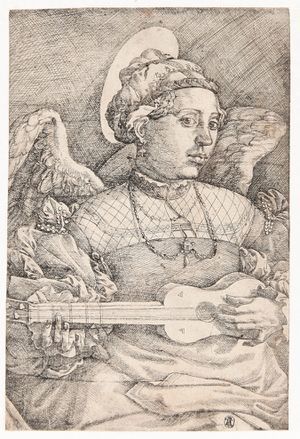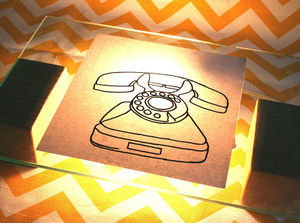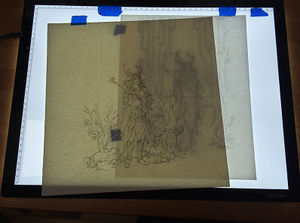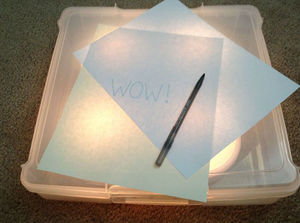Difference between revisions of "User:Elise.cai"
| Line 7: | Line 7: | ||
# Measure the work of art and note down these measurements | # Measure the work of art and note down these measurements | ||
# Take a flat photo with a suitable camera | # Take a flat photo with a suitable camera | ||
| + | # Accurately print a photo copy with the correct measurements | ||
# Research the paper and tools used to print the work | # Research the paper and tools used to print the work | ||
| − | |||
# Acquire a light box and put the photo in it | # Acquire a light box and put the photo in it | ||
# Carefully trace to copy the style of the work on your selected paper | # Carefully trace to copy the style of the work on your selected paper | ||
Revision as of 00:17, 6 June 2018
Research - Stealing from the museum
My method to steal and copy from the museum requires patience and perfection. The work I chose is called Musicerende Engel and was created by Jan Cornelisz Vermeyen in 1545.
It is a relatively small print and was made possible through a combination of etching and engraving. Below I will invent a step by step tutorial on how to copy a piece like this:
- Measure the work of art and note down these measurements
- Take a flat photo with a suitable camera
- Accurately print a photo copy with the correct measurements
- Research the paper and tools used to print the work
- Acquire a light box and put the photo in it
- Carefully trace to copy the style of the work on your selected paper
The aim of this method is to be realistic as it provides a simple and low budget do-it-yourself strategy to copy printed sketches like the Musicerende Engel even though it may not be completely accurate.
It is designed for people like me who do not have access to etching or engraving tools or lack the knowledge to do so.
After doing some research I have found that it is indeed possible to make your own cheap tracing light box.
I will illustrate this with some photo examples below of homemade light boxes as pictures explain more than a thousand words. Click to enlarge.
Research - The idea of beauty
As a 2D illustrator I am mainly intrigued by 2D works as well. Upon entering a department in the museum that was filled to the brim with traditional and rather old sketches, one of them stood out to me in particular. A small framed work, next to many bigger drawings caught my attention in the corner of my eye. It was this work by Jan Cornelisz Vermeyen that I observed and pondered about. Despite being a colourless sketch, the idea was clear. I noticed instantly how this representation of an angel was off to me, as one would normally think this lady would be an ordinary woman and not a heavenly creature until you pay closer attention and notice the little wings behind her and her halo. People back then had different standards for beauty than our society does now and what better to represent beauty than through an angel? This lead me to do research into the meaning behind beauty and what affects people to think differently about this definition. What changed in our history and why? Is there a way for me to emphasize that beauty is subjective in my copy and reproduction since the standards for beauty change constantly anyway? Concluding this, my research question is the following: What causes our ideal of beauty to change throughout our history?



